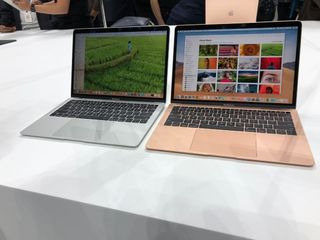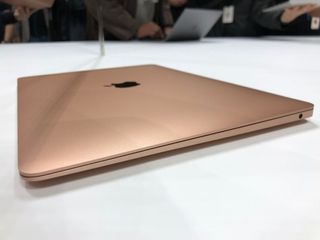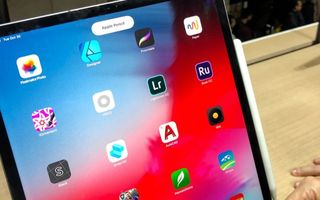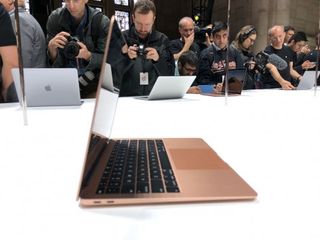MacBook Air vs. iPad Pro: Which Should You Buy?
Apple finally overhauled the MacBook Air with major improvements to its design, performance and display. The new 13.3-inch laptop sports a Retina display and a slimmer, sleeker design.
The premium device is now up-to-date with Apple's other products, including the newly refreshed iPad Pro. Along with a 12.9-inch model, the tablet now comes with an 11-inch display. Both versions feature an edge-to-edge screen, along with Face ID login and more powerful internals.

Choosing between the MacBook Air and iPad Pro is no easy task. If you can't make up your mind between tablet and traditional laptop, ask yourself how you'll use the device and which form factor you prefer.
Here is how the new MacBook Air stacks up against the new iPad Pros.
Design
The MacBook Air finally received a redesign after three long years of waiting. The new laptop is smaller, sleeker and weighs less than its predecessor. It also sports a Retina display within bezels that are 50 percent narrower. Touch ID is built into the top right corner of the keyboard and the top-firing speakers are said to be 25 percent louder. There is also a three-mic array to improve Siri recognition and a T2 security chip for keeping files and data safe.

The MacBook Air doesn't stray far from Apple's signature design language, with a chassis that looks a lot like the 12-inch MacBook and the MacBook Pro. The unibody laptop, available in silver, space gray and gold, is made from 100 percent recycled aluminum.
At 12 x 8.4 x 0.6 inches, the MacBook Air is considerably smaller than its predecessor but larger than our favorite Windows laptop, the Dell XPS 13 (12 x 7.9 x 0.5 inches), which packs a more powerful U-series CPU.
Stay in the know with Laptop Mag
Get our in-depth reviews, helpful tips, great deals, and the biggest news stories delivered to your inbox.
Apple made similar changes to the iPad Pro, which comes with an 11-inch or 12.9-inch display. The display now stretches to each edge of the device. To make the feature work, Apple did away with the Touch ID button and employed the rounded Liquid Retina technology from the iPhone XR's display.

Replacing the fingerprint sensor on the top bezel is Face ID, Apple's facial recognition technology first introduced in the iPhone X. With smaller bezels, the iPad Pro is more compact than ever. In fact, the 11-inch version (9.7 x 7 x 0.2 inches) is about the same size as the previous 10.5-inch model, while the 12.9-inch (11 x 8.5 x 0.2 inches) tablet is now the size of a standard piece of paper.
iPad Pro vs. MacBook Air: Specs Compared
| Row 0 - Cell 0 | MacBook Air | iPad Pro (12.9-inch) | iPad Pro (11-inch) |
| Starting Price | $1,199 | $999 | $799 |
| Display | 13.3-inch, 2560 x 1600-pixels | 12.9-inch, 2732 x 2048-pixels | 11-inch, 2388 x 1668-pixels |
| CPUs | 8th Gen Intel Y-series Core i5 | A12X Bionic | A12X Bionic |
| Battery Life | 12 hours (web browsing) | 10 hours | 10 hours |
| Storage | 128GB, 256GB, 512GB, 1.5TB | 64GB, 256GB, 512GB, 1TB | 64GB, 256GB, 512GB, 1TB |
| RAM | 8GB, 16GB | N/A | N/A |
| Cameras | 720p | 7MP (front-facing), 12MP (rear-facing) | 7MP (front-facing), 12MP (rear-facing) |
| Weight (pounds) | 2.75 pounds | 1.4 pounds | 1 pound |
| Thickness (inches) | 0.6 inches | 0.2 inches | 0.2 inches |
| Face ID | No | Yes | Yes |
| Compatible Accessories | N/A | Pencil, Smart Keyboard Folio | Pencil, Smart Keyboard Folio |
| Ports | 2 Thunderbolt 3, headphone | USB-C | USB-C |
Pricing and Configuration Options
The MacBook Air starts at $1,199 for an 8th Y-series Core i5 CPU, 8GB of RAM, a 128GB SSD and an Intel UHD Graphics 617 GPU. Doubling storage capacity to 256GB costs an extra $200, and another $200 gets you 512GB of space.
From that $1,599 configuration, you'll spend an additional $800 for 1.5TB of storage. Apple also charges $200 to double the MacBook Air's memory from 8GB to 16GB. With all of those upgrades, a top-of-the-line MacBook Air— with a Core i5 CPU, 16GB of RAM and a 1.5TB SSD — costs $2,599.
The two iPad Pro models also cost more than their predecessors. The 11-inch version goes for $799 while the 12.9-inch model starts at $999. You can choose from four storage options: 64GB, 256GB, 512GB and 1TB. Increasing storage capacity from 64GB to 256GB costs $150, and you'll spend another $200 going from 256GB to 512GB. The 11-inch iPad Pro with 1TB of storage costs $1,549 while the 12.9-inch costs $1,749.
Display
Finally, the MacBook Air will come with a Retina display. The 13.3-inch panel has 4 million pixels with a resolution of 2560 x 1600 (227 ppi), so images should look much sharper than they did on the previous display. Apple also says the panel is 48 percent more colorful in the new version. With 50 percent narrower bezels, the MacBook Air should provide an immersive viewing experience.

The displays on the new iPad Pros may not jump out on the specs sheets, but they use an entirely new technology: Liquid Retina, which allows Apple to stretch the iPad Pros' rounded displays to the tablet's edges. Apple says these new 11-inch-and-12.9-inch panels are more color accurate and brighter than ever before. The displays also have True Tone white balance and Pro Motion refresh rates.
Ports
Apple did away with the USB 3.0 port, so connecting peripherals could prove tricky on the MacBook Air. In its place are two Thunderbolt 3 ports for charging or connecting to multiple monitors and eGPUs. Music junkies can breathe a sigh of relief — the right side of the MacBook Air houses a 3.5mm headphone jack.

However, those tied to their wireless earbuds will be disappointed with the new iPad Pros, which ditch the headphone jack and embrace USB-C in favor of the lightning connector.
Keyboard and Pen
The new MacBook Air adopts the polarizing Butterfly keyboard found on the latest MacBook Pro. We suspect the keyboard will have very short key travel and stiff feedback. That said, Apple claims the individually backlit keys will be four times more stable than before.
The size of the trackpad has also been increased by 20 percent. Apple makes some great trackpads, so we expect the new MacBook Air's to be fluid and responsive.

Apple revamped the Pencil and Smart Keyboard Folio for the new iPad Pro models. The stylus now magnetically attaches to the iPad Pro and charges wirelessly at the same time. The accessory has a new sensor that detects taps and allows you to control apps in new ways. The new Smart Keyboard is more flexible this time around so you can adjust the angle of the iPad's display to your liking.
Battery Life
Apple rates the MacBook Air's battery life at 12 hours of web browsing and 13 hours of continuous movie playback. That is an hour longer than the previous MacBook Air, which lasted 10 hours and 26 minutes on our Laptop Mag battery test (continuous web browsing over Wi-Fi at 100 nits of brightness).

Apple rated the battery life of both the 11-inch and 12.9-inch iPad Pros at 10 hours of continuous web surfing. The 10.5-inch iPad Pro, with the same 10-hour battery life rating, lasted an impressive 13 hours and 55 minutes on our test.
Outlook
Both the iPad Pro and MacBook Air received welcome design changes, upgraded internals, and several new features. The iPad Pro was already one of the best tablets on the market, but now the MacBook Air was given the overhaul it desperately needed to catch up. With 8th Gen CPUs and a Retina Display, the popular premium laptop has finally been revitalized.

If you're torn between these two devices, you'll need to consider how you intend on using them. If you primarily use iOS apps and don't need a keyboard or headphone jack, then the iPad Pro is a good choice, offering tons of power, an excellent display, and long battery life. However, if you need a traditional laptop with a keyboard/touchpad and the ability to download third-party programs, the MacBook Air might just be the product for you.
Phillip Tracy is the assistant managing editor at Laptop Mag where he reviews laptops, phones and other gadgets while covering the latest industry news. After graduating with a journalism degree from the University of Texas at Austin, Phillip became a tech reporter at the Daily Dot. There, he wrote reviews for a range of gadgets and covered everything from social media trends to cybersecurity. Prior to that, he wrote for RCR Wireless News covering 5G and IoT. When he's not tinkering with devices, you can find Phillip playing video games, reading, traveling or watching soccer.

